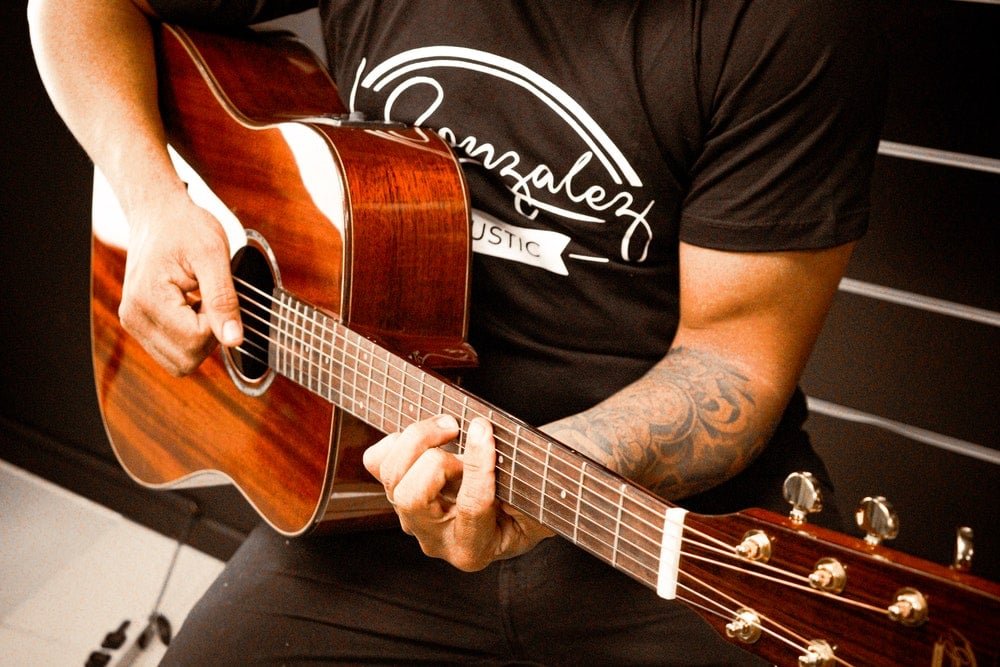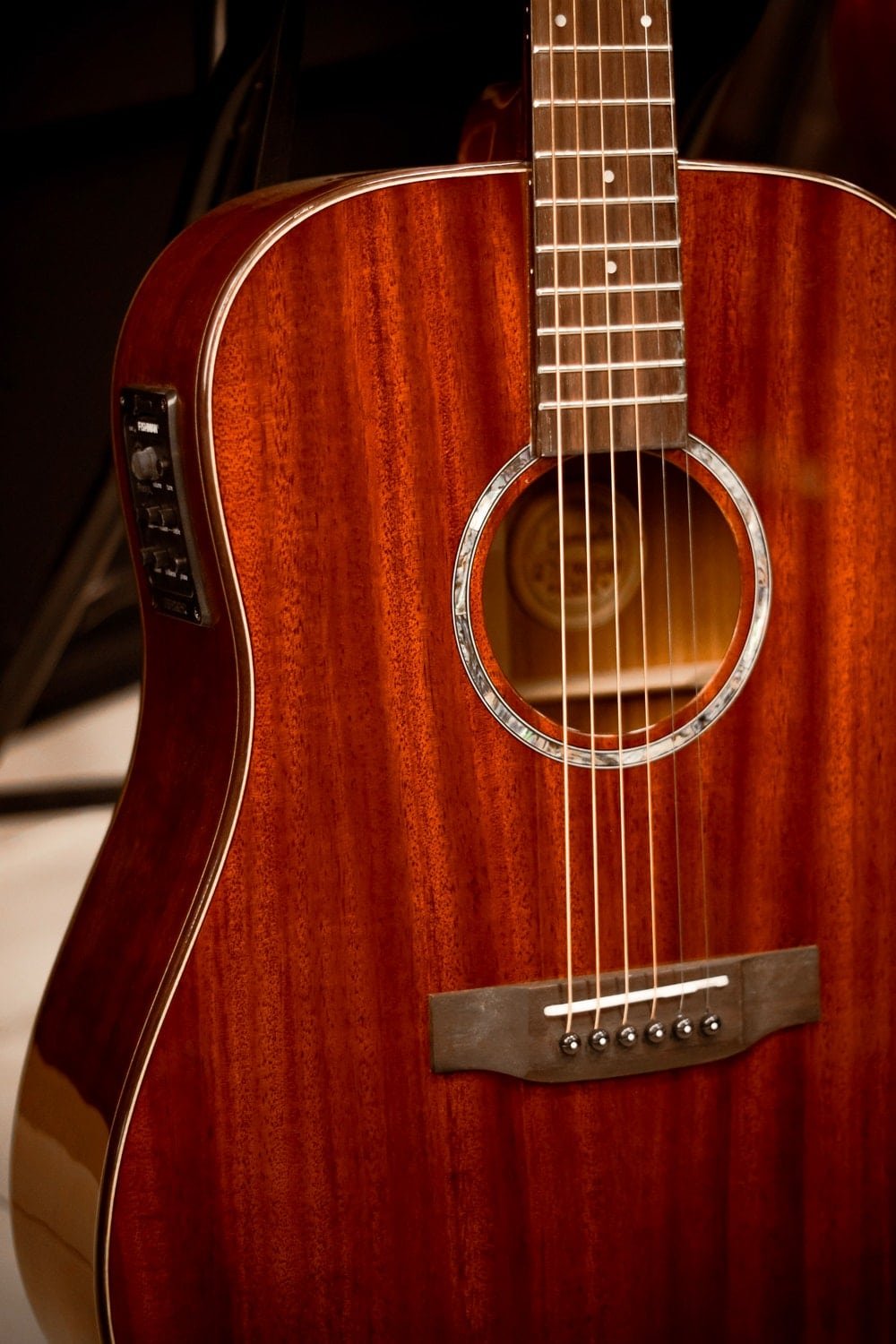Picture this: It’s the afternoon before a trip with your friends, and you’re practicing the songs you know on the guitar.
All of a sudden, one of the strings on your dad’s old guitar gives, and there are no spare strings to be found at home!
You go to the closest music shop available to your home, and as you’re standing there, it hits you: you have no clue as to how to choose a guitar string for your guitar!
There are all kinds of strings in the store, and you don’t even know where to begin with all the different types and numbers on the label.
Not to fret (pun intended), as that is exactly what brought you to this guide.
Here, I’ll help break down all the numbers and types that you might possibly deal with to ultimately help you deal with the perfect string to choose for your guitar.
Contents
Guitar Type
First and foremost comes the type of guitar you own.
You can’t choose the perfect string if you don’t know what kind of guitar you have because the guitar strings will vary.
Acoustic guitars have different gauges, materials, and cores from electric guitars.
If you’re unsure, then it’s best to show the store your guitar or simply a picture of your guitar.
From there, you can now pick what kind of guitar you have.
Pitch
As you may already know, each string on your guitar plays a different pitch.
A combination of fretting the guitar and strumming or plucking the strings, which is also why it gets worn down over time and breaks.
The pitch depends on what order the string belongs to on your guitar.
It’s best to know beforehand where it belongs in the arrangement, so you’ll find the perfect size for it.
Furthermore, it might be of great help to bring your guitar to the shop so they can possibly pick out a string for you (and maybe even replace it)!
String Gauge
String gauge determines the thickness of the string, and the thickness of the string is not only for the pitch, but for your playstyle as well.
If you prefer strumming, then thicker strings are the way to go, whereas thinner strings are better for those who prefer to finger-pick.
Gauges are assigned by numbers, and are measured by the thousands of an inch.
They can range from extra-light to heavy strings, and each one will vary between electric and acoustic guitars.
Strings can also be bought in sets or alone, so it’s ultimately your choice to change all the strings or just the broken one on your guitar.
Extra Light
Acoustic guitar strings are often ranged from .01 to .047, with the former being on the top string and the latter being on the lowest string (assuming this is a set).
Electric guitar strings would range from .009 to .008 for the top string. Extra light strings tend to give more easily, but they are said to be easier to play.
Light
Light acoustic guitar strings range from .012 to .053, while electric guitars tend to be .01 to .046.
These strings are thicker and more durable than extra light strings while still maintaining a nice tone.
Medium
Medium strings begin the range from .013 for acoustic guitars, while electric guitars start from .011.
They’re commonly used for blues or rock music players, as their tones can be quite heavier.
However, they are still playable given that a certain degree of bending would require some effort.
Heavy
Heavy strings for acoustic guitars start at .014 while electric guitars start at .012. They’re mostly popular in jazz, where string bending is not really emphasized.
And even though they’re the most durable, they can be quite hard to play when you want to achieve a specific tone.
String Materials
String material is also one of the factors you should consider when picking out guitar strings.
The strings are made of conducive metal so it is able to convert the vibrations into music.
Acoustic guitars on the other hand, are made from various materials, depending on the specific guitar you have.
The most common materials for the strings are pure nickel, nickel-plated steel, and stainless steel. Acoustic guitars can be made from catgut, nylon, bronze alloy, and more.
Just like with string gauges, choosing materials boils down to preference and the type of music you play.
Also Read: Phosphor Bronze vs 80/20 Guitar Strings: Which is the Best?
Windings
Guitar strings consist of a core wrapped around certain material, which is called string winding.
There are three types of winding, roundwound, which is the most popular among acoustic players, flatwound, which is most popular for jazz and blues players, and half-round, which is a mix of both (and is the most difficult to find.
Roundwound strings are the most popular because of their ribbed texture and brighter sound.
Half-round strings are designed to be smoother while giving a warmer, deeper tone.
Lastly, flatwound strings are designed to have the smoothest surface compared to the previous two, giving it a vintage sound that is preferred by most blues or jazz players.
Coating
Guitar strings have a tendency to break not only from all the pulling and bending, but also because of the finger oil you apply when you play.
Strings are coated to increase durability and lifespan, and the coating is often a polymer.
However, opting for a coated string reduces the brightness of the string’s sound, so it’s a give-and-take situation.
The two types of coating are nanoweb which is lightly coated and can almost produce uncoated string sounds, and polyweb, which tends to be thicker and more durable, but with reduced sound quality.
String Core
String cores also boil down to preference and the type of music you play.
Hex cores have a hexagonal wire, which gives a more consistent tone as compared to round cores. They are also by far the most common and easiest to find.
Round cores, on the other hand, provide a mellower sound, which is what most jazz players prefer.
However, their sound quality tends to degrade much more easily than hex cores, so it always boils down to what you want to decide.
Conclusion
Given all these factors to consider when choosing good acoustic guitar strings, it’s best to find a mix-and-match of all factors to find the perfect one for you.
Then again, if you’re still unsure, it would be best to just bring your guitar to the store and have the clerks give you advice.
They know their music instruments or would have someone around who does, so they are more than qualified to help you out.






